Assessment of Environmental Risks of Particulate Matter Emissions from Road Transport Based on the Emission Inventory
Abstract
:1. Introduction
1.1. Background Information on Particulate Matter Emissions from Road Transport
- engine exhaust gases;
- tribological processes of a motor vehicle that cooperates with its environment, specifically the particulates derived from the braking system, friction clutch, car parts subject to wear and tires, as well as the surfaces of roads.
- total suspended particles (TSP)—with an average aerodynamic diameter of less than 300 µm;
- fine particles PM10—with an average aerodynamic diameter of less than 10 µm;
- fine particles PM2.5—fine inhalable particles with an average aerodynamic diameter less than 2.5 µm and colloidal fragmentation;
- ultrafine particles PM1—with an average aerodynamic diameter of less than 1 µm, practically invisible, distinguished in tests on internal combustion engines (particles with an average aerodynamic diameter of less than 100 nm, called nanoparticles, are separated from PM1; sometimes solid particles with dimensions smaller than 50 nm are also distinguished).
1.2. Particulate Matter Environmental Hazards and the Protection of Environment against Particulate Matter Emission from Road Transport—Legal Status
- PM10 particulate matter;
- PM2.5 particulate matter;
- PM1 particulate matter.
- The specific distance particulate matter emission (bPM)
- The specific distance number of particulate matter (bPN):
- The specific brake emission of particulate matter (ePM)
- The specific brake number of particulate matter (ePN)
1.3. Current State of Knowledge on Particulate Matter Emissions from Road Transport
2. Methodology for Studying Environmental Risks of Particulate Matter from Road Transport Based on Emission Inventory
- motor vehicle purpose of use;
- motor vehicle conventional size and propulsion engine;
- characteristics of the motor vehicle and its propulsion engines as regards, among others, the engine cycle, detailed technical solutions and performance, primarily with respect to pollutant emissions;
- power fuel for the motor vehicle’s internal combustion engine;
- technical level of motor vehicle and its propulsion engine.
- passenger cars;
- light commercial vehicles;
- heavy duty trucks;
- buses;
- mopeds and motorcycles (and microcars and quads).
- internal combustion engine displacement—for passenger cars, light trucks, motorcycles and mopeds (and possibly quads);
- maximum mass—for trucks and buses and, additionally, light trucks.
- motor gasoline;
- diesel fuel;
- fuels based on organic oil esters (so-called biodiesel);
- ethyl alcohol;
- liquefied petroleum gas (LPG);
- natural gas.
- inside cities;
- outside cities;
- on motorways and expressways (highways).
- vehicle average velocity;
- share of the distance travelled by vehicles in a given traffic model versus the total distance travelled in all traffic models.
- number of motor vehicles;
- average annual mileage of motor vehicles.
- share of particle emissions in total particulate matter emissions;
- share of particle emissions and total particulate matter emissions from sources other than vehicle exhaust in particle emissions in total particulate matter emissions from all sources;
- influence of vehicle traffic models on specific fractions of particulate matter emissions and on total emissions of particulate matter inside and outside cities, as well as on highways.
3. Results on Environmental Hazards from Road Transport Particulate Matter Based on the Emission Inventory
4. Conclusions
- The highest relative annual emission of PM10 particles (78%) and PM10 from sources other than engine exhaust gases was 41%. The relative annual emission of PM2.5 from sources other than exhaust gases was the lowest (22%).
- The total particulate matter emissions from sources other than exhaust gases constituted 62% of PM total emissions.
- The highest relative national annual emissions of particulate matter from sources other than engine exhaust gases were observed for urban and non-urban vehicle traffic (40–50%), and the lowest was observed on highways (10%).
Author Contributions
Funding
Institutional Review Board Statement
Informed Consent Statement
Data Availability Statement
Conflicts of Interest
Abbreviations
| BC | black carbon (soot) |
| bPM | specific distance particulate matter emission |
| bPN | specific distance number of particulate matter |
| C | coaches |
| E | national annual emission |
| EEA | European Environmental Agency |
| EMEP | European Monitoring and Evaluation Programme |
| ePM | specific brake emission of particulate matter |
| ePN | specific brake number of particulate matter |
| Er | relative national annual emission |
| ETC | European Transient Cycle |
| H | highway |
| HDT | heavy duty trucks |
| L | work |
| LCV | light commercial vehicles |
| LPG | liquefied petroleum gas |
| Mc | motorcycles |
| Mp | mopeds |
| mPM | emission of particulate matter |
| N | number of vehicles |
| P | annual mileage of vehicles |
| PC | passenger cars |
| PM10 | particulate matter with a mean aerodynamic diameter less than 10 µm |
| PM10-N-Exh | PM10—non-exhaust |
| PM10-T-PM10 | total |
| PM2.5 | PM with an average aerodynamic diameter less than 2.5 µm |
| PM2.5-N-Exh | PM2.5—non-exhaust |
| PM2.5-T | PM2.5—total |
| PM-TSP-T | TSP—total |
| PN | number of particulate matter |
| R | rural |
| s | distance |
| TSP | total suspended particles |
| TSP-N-Exh-TSP | non-exhaust |
| u | share of vehicle distance in traffic conditions in all distance |
| U | urban |
| UB | urban buses |
| V | vehicles |
| vAV | average velocity of vehicle |
References
- Bebkiewicz, K.; Chłopek, Z.; Lasocki, J.; Szczepański, K.; Zimakowska-Laskowska, M. Inventory of Pollutant Emission from Motor Vehicles in Poland Using the COPERT 5 Software. Combust. Engines 2019, 178, 150–154. [Google Scholar] [CrossRef]
- Bebkiewicz, K.; Chłopek, Z.; Szczepański, K.; Zimakowska-Laskowska, M. Issues of Modeling the Total Pollutant Emission from Vehicles. Proc. Inst. Veh. 2017, 110, 103–117. [Google Scholar]
- Bebkiewicz, K.; Chłopek, Z.; Szczepański, K.; Zimakowska-Laskowska, M. Results of Air Emission Inventory from Road Transport in Poland in 2014. Proc. Inst. Veh. 2017, 110, 77–88. [Google Scholar]
- Bebkiewicz, K.; Chłopek, Z.; Lasocki, J.; Szczepański, K.; Zimakowska-Laskowska, M. The Inventory of Pollutants Hazardous to the Health of Living Organisms, Emitted by Road Transport in Poland between 1990 and 2017. Sustainability 2020, 12, 5387. [Google Scholar] [CrossRef]
- Chłopek, Z.; Suchocka, K.; Dudek, M.; Jakubowski, A. Hazards Posed by Polycyclic Aromatic Hydrocarbons Contained in the Dusts Emitted from Motor Vehicle Braking Systems. Arch. Environ. Prot. 2016, 42, 3–10. [Google Scholar] [CrossRef] [Green Version]
- Chłopek, Z. Testing of hazards to the environment causes by particulate matter during use of vehicles. Eksploat. Niezawodn. Maint. Reliab. 2012, 14, 160–170. [Google Scholar]
- COPERT 5—Manual. Available online: https://copert.emisia.com/manual/ (accessed on 26 February 2021).
- EMEP/EEA Air Pollutant Emission Inventory Guidebook 2019—European Environment Agency. Available online: https://www.eea.europa.eu/publications/emep-eea-guidebook-2019 (accessed on 26 February 2021).
- Englert, N. Fine Particles and Human Health—A Review of Epidemiological Studies. Toxicol. Lett. 2004, 149, 235–242. [Google Scholar] [CrossRef]
- US EPA. AP-42: Compilation of Air Emissions Factors. Available online: https://www.epa.gov/air-emissions-factors-and-quantification/ap-42-compilation-air-emissions-factors (accessed on 26 February 2021).
- European Union Emissions Inventory Report 2017—European Environment Agency. Available online: https://www.eea.europa.eu/publications/european-union-emissions-inventory-report-2017 (accessed on 26 February 2021).
- Jakubiak-Lasocka, J.; Lasocki, J.; Siekmeier, R.; Chłopek, Z. Impact of Traffic-Related Air Pollution on Health. Adv. Exp. Med. Biol. 2015, 834, 21–29. [Google Scholar] [CrossRef]
- Oliveira, L.M.; Savvidis, D.; Sr, M.P. Controlling Particulate Matter Emissions in Vehicles Using Different Strategies under the Heavy-Duty Test Cycle; SAE Technical Paper 2012-01-0885; SAE International: Warrendale, PA, USA, 2012. [Google Scholar] [CrossRef]
- Chłopek, Z.; Jakubowski, A. A study of the particulate matter emission from the braking systems of motor vehicles. Eksploat. Niezawodn. Maint. Reliab. 2009, 44, 45–52. [Google Scholar]
- 1990–2016 Air Pollutant Emission Inventory Report. Canada 2018. Government of Canada, P. S. and P. C. Available online: http://publications.gc.ca/site/archivee-archived.html?url=http://publications.gc.ca/collections/collection_2018/eccc/En81-26-2016-eng.pdf (accessed on 26 February 2021).
- Eggleston, S.; Buendia, L.; Miwa, K.; Ngara, T.; Tanabe, K. (Eds.) IPCC 2006, 2006 IPCC Guidelines for National Greenhouse Gas Inventories, Prepared by the National Greenhouse Gas Inventories Programme. 2006. Available online: https://www.ipcc-nggip.iges.or.jp/public/2006gl/ (accessed on 26 February 2021).
- USA Environmental Protection Agency. 2017 National Emissions Inventory: January 2021 Updated Release, Technical Support Document 2021. Available online: https://www.epa.gov/sites/production/files/2021-02/documents/nei2017_tsd_full_jan2021.pdf (accessed on 26 February 2021).
- Air Quality Team. Department for Environment, Food and Rural Affairs. Call for Evidence on Brake, Tyre and Road Surface Wear 2018. 14p. Available online: https://consult.defra.gov.uk/airquality/brake-tyre-and-road-surface-wear/user_uploads/air-quality-road-surface-wear-call-for-evidence.pdf (accessed on 26 February 2021).
- Cuspilici, A.; Monforte, P.; Ragusa, M.A. Study of Saharan dust influence on PM10 measures in Sicily from 2013 to 2015. Ecol. Indic. 2017, 76, 297–303. [Google Scholar] [CrossRef]
- Pinto, J.T.D.; Mistage, O.; Bilotta, P.; Helmers, E. Road-rail intermodal freight transport as a strategy for climate change mitigation. Environ. Dev. 2018, 25, 100–110. [Google Scholar] [CrossRef]
- Chłopek, Z.; Żegota, M. The emission of particulate matter PM10 from vehicles. Eksploat. Niezawodn. Maint. Reliab. 2004, 21, 3–13. [Google Scholar]
- Grigoratos, T.; Martini, G.; European Commission; Joint Research Centre; Institute for Energy and Transport. Non-Exhaust Traffic Related Emissions—Brake and Tyre Wear PM: Literature Review; JCR Science and Police Reports; European Union: Luxembourg, 2014. [Google Scholar]
- Lohmeyer, A.; Düring, I. Validierung von PM10-Immissionsberechnungen im Nahbereich von Straßen und Quantifizierung der Staubbildung von Straßen, Lützner Straße in Leipzig. Auftraggeber: Sächsisches Landesamt für Umwelt und Geologie; Dresden über Staatliche Umweltbetriebsgesellschaft: Radebeul, Germany, 2001. [Google Scholar]
- Chłopek, Z.; Dębski, B.; Szczepański, K. Theory and Practice of Inventory Pollutant Emission from Civilization-Related Sources: Share of the Emission Harmful to Health from Road Transport. Arch. Automot. Eng. Arch. Motoryz. 2018, 79, 5–22. [Google Scholar] [CrossRef]
- EPA. Addendum to Emission Factor Documentation for AP-42, Section 11.2.5 and 11.2.6 (now 13.2.1). Paved Roads. Final Report. 1997. Available online: https://www3.epa.gov/ttn/chief/old/ap42/ch13/s021/bgdoc/b13s0201_addendum_1997.pdf (accessed on 26 February 2021).
- Karagulian, F.; Belis, C.A.; Dora, C.F.C.; Prüss-Ustün, A.M.; Bonjour, S.; Adair-Rohani, H.; Amann, M. Contributions to Cities’ Ambient Particulate Matter (PM): A Systematic Review of Local Source Contributions at Global Level. Atmos. Environ. 2015, 120, 475–483. [Google Scholar] [CrossRef]
- Krzeszowiak, J.; Stefanow, D.; Pawlas, K. The Impact of Particulate Matter (PM) and Nitric Oxides (NOx) on Human Health and an Analysis of Selected Sources Accounting for Their Emission in Poland. Med. Sr. Environ. Med. 2016, 19, 7–15. [Google Scholar] [CrossRef]
- Wiwanitkit, V. PM10 in the Atmosphere and Incidence of Respiratory Illness in Chiangmai during the Smoggy Pollution. Stoch. Environ. Res. Risk Assess. 2008, 22, 437–440. [Google Scholar] [CrossRef]
- Poland’s Informative Inventory Report 2019; Submission under the UN ECE Convention on Long-Range Transboundary Air Pollution and the Directive (EU) 2016/2284; Institute of Environmental Protection—National Research Institute, National Centre for Emission Management (KOBiZE): Warsaw, Poland, 2019.
- Worldwide Emission Standards. Heavy Duty & Off-Road Vehicles. Delphi. Innovation for the Real World. 2016/2017. Available online: https://www.delphi.com/sites/default/files/inline-files/2016-2017-heavy-duty-amp-off-highway-vehicles_0.pdf?sfvrsn=0.03636262961639791&status=Temp (accessed on 26 February 2021).
- Worldwide Emission Standards. Passenger Cars and Light Duty Vehicles. Delphi. Innovation for the Real World. 2016/2017. Available online: https://www.delphi.com/sites/default/files/inline-files/delphi-worldwide-emissions-standards-passenger-cars-light-duty-2016-7.pdf (accessed on 26 February 2021).
- Fiebig, M.; Wiartalla, A.; Holderbaum, B.; Kiesow, S. Particulate Emissions from Diesel Engines: Correlation between Engine Technology and Emissions. J. Occup. Med. Toxicol. 2014, 9, 6. [Google Scholar] [CrossRef] [PubMed] [Green Version]
- Chłopek, Z.; Jakubowski, A. The examination of the reduction of particulate matter emission from motor vehicle braking systems. Eksploat. Niezawodn. Maint. Reliab. 2009, 48, 29–36. [Google Scholar]
- Petrović, V.S. Particulate Matters from Diesel Engine Exhaust Emission. Therm. Sci. 2008, 12, 183–198. [Google Scholar] [CrossRef]
- Diane, U.; Keogh, D.U.; Kelly, J.; Mengersen, K.; Jayaratne, R.; Ferreira, L.; Morawska, L. Derivation of motor vehicle tailpipe particle emission factors suitable for modelling urban fleet emissions and air quality assessments. Environ. Sci. Pollut. Res. 2010, 17, 724–739. [Google Scholar] [CrossRef] [Green Version]
- Lopes, D.; Ferreira, J.; Hoi, K.I.; Yuen, K.-V.; Mok, K.M.; Miranda, A.I. Emission Inventories and Particulate Matter Air Quality Modeling over the Pearl River Delta Region. Int. J. Environ. Res. Public Health 2021, 18, 4155. [Google Scholar] [CrossRef] [PubMed]
- EDGAR—Emissions Database for Global Atmospheric Research. Available online: https://edgar.jrc.ec.europa.eu (accessed on 8 June 2021).
- Giechaskiel, B.; Joshi, A.; Ntziachristos, L.; Dilara, P. European Regulatory Framework and Particulate Matter Emissions of Gasoline Light-Duty Vehicles: A Review. Catalysts 2019, 9, 586. [Google Scholar] [CrossRef] [Green Version]
- Panko, J.M.; Hitchcock, K.M.; Fuller, G.W.; Green, D. Evaluation of Tire Wear Contribution to PM2.5 in Urban Environments. Atmosphere 2019, 10, 99. [Google Scholar] [CrossRef] [Green Version]
- Platt, S.M.; El Haddad, I.; Pieber, S.M.; Zardini, A.A.; Suarez-Bertoa, R.; Clairotte, M.; Daellenbach, K.R.; Huang, R.-J.; Slowik, J.G.; Hellebust, S.; et al. Gasoline Cars Produce More Carbonaceous Particulate Matter than Modern Filter-Equipped Diesel Cars. Sci. Rep. 2017, 7, 4926. [Google Scholar] [CrossRef]
- Chłopek, Z.; Piaseczny, L. Remarks about the modelling in science researches. Eksploat. Niezawodn. Maint. Reliab. 2001, 4, 47–57. [Google Scholar]
- Gramstat, S.; Mertens, T.; Waninger, R.; Lugovyy, D. Impacts on Brake Particle Emission Testing. Atmosphere 2020, 11, 1132. [Google Scholar] [CrossRef]
- Penkała, M.; Ogrodnik, P.; Rogula-Kozłowska, W. Particulate Matter from the Road Surface Abrasion as a Problem of Non-Exhaust Emission Control. Environments 2018, 5, 9. [Google Scholar] [CrossRef] [Green Version]
- Sommer, F.; Dietze, V.; Baum, A.; Sauer, J.; Gilge, S.; Maschowski, C.; Gieré, R. Tire Abrasion as a Major Source of Microplastics in the Environment. Aerosol Air Qual. Res. 2018, 18, 2014–2028. [Google Scholar] [CrossRef]
- Bai, S.; Du, Y.; Reid, S. Contributions of Tire Wear and Brake Wear to Particulate Matter Emissions Inventories for On-Road Mobile Sources 2015. 22p. Available online: https://www.epa.gov/sites/production/files/2015-09/documents/sbai_pres.pdf (accessed on 26 February 2021).
- Strzałkowska, K. Modeling of Emission of Dimensional Fractions of Solid Particles for the Purpose of Assessing the Impact of Pollutants from Sources Automotive on the Environment. Ph.D. Thesis, Warsaw University of Technology, Warsaw, Poland, 20 February 2021. (In Polish). [Google Scholar]
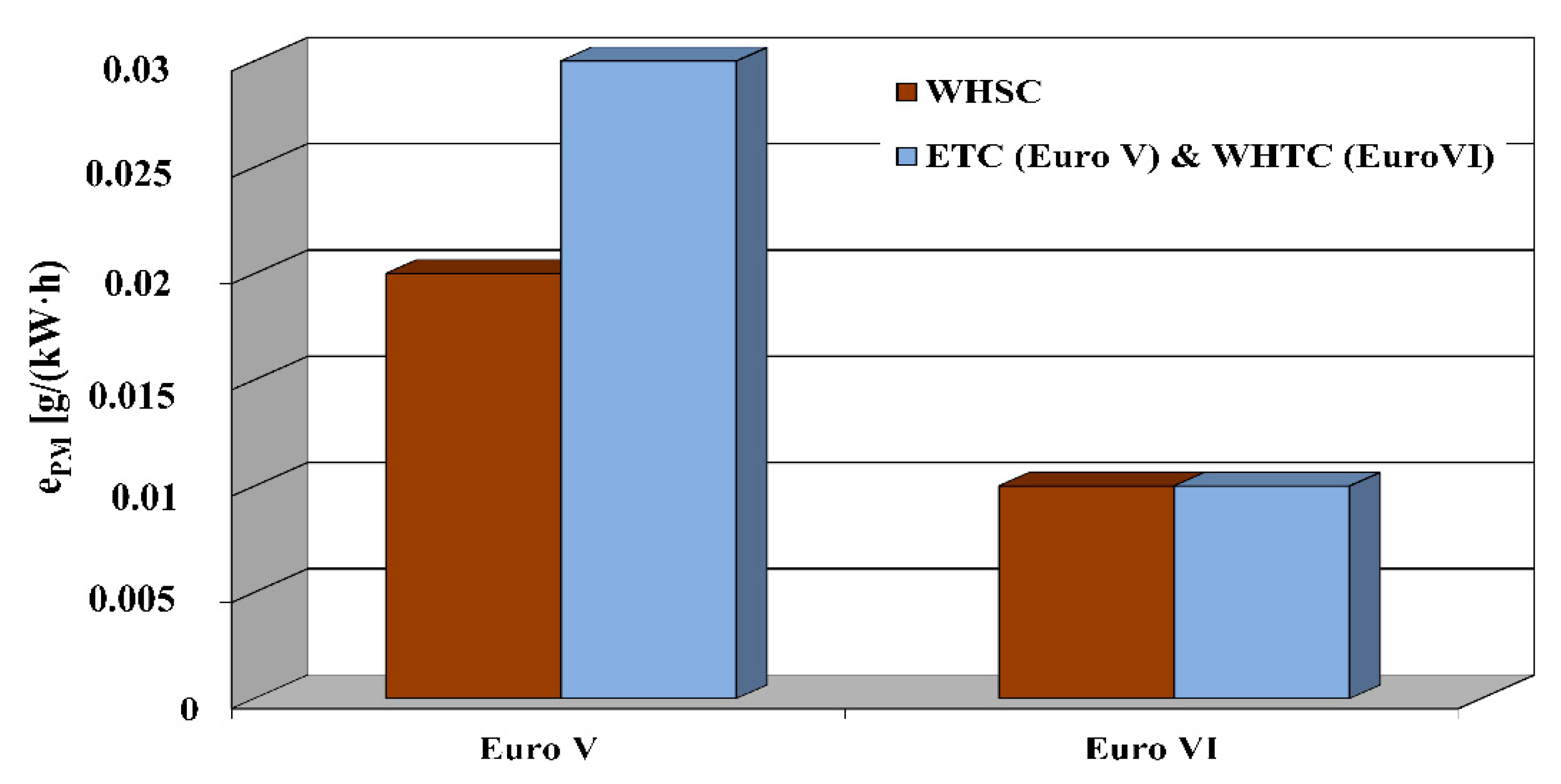
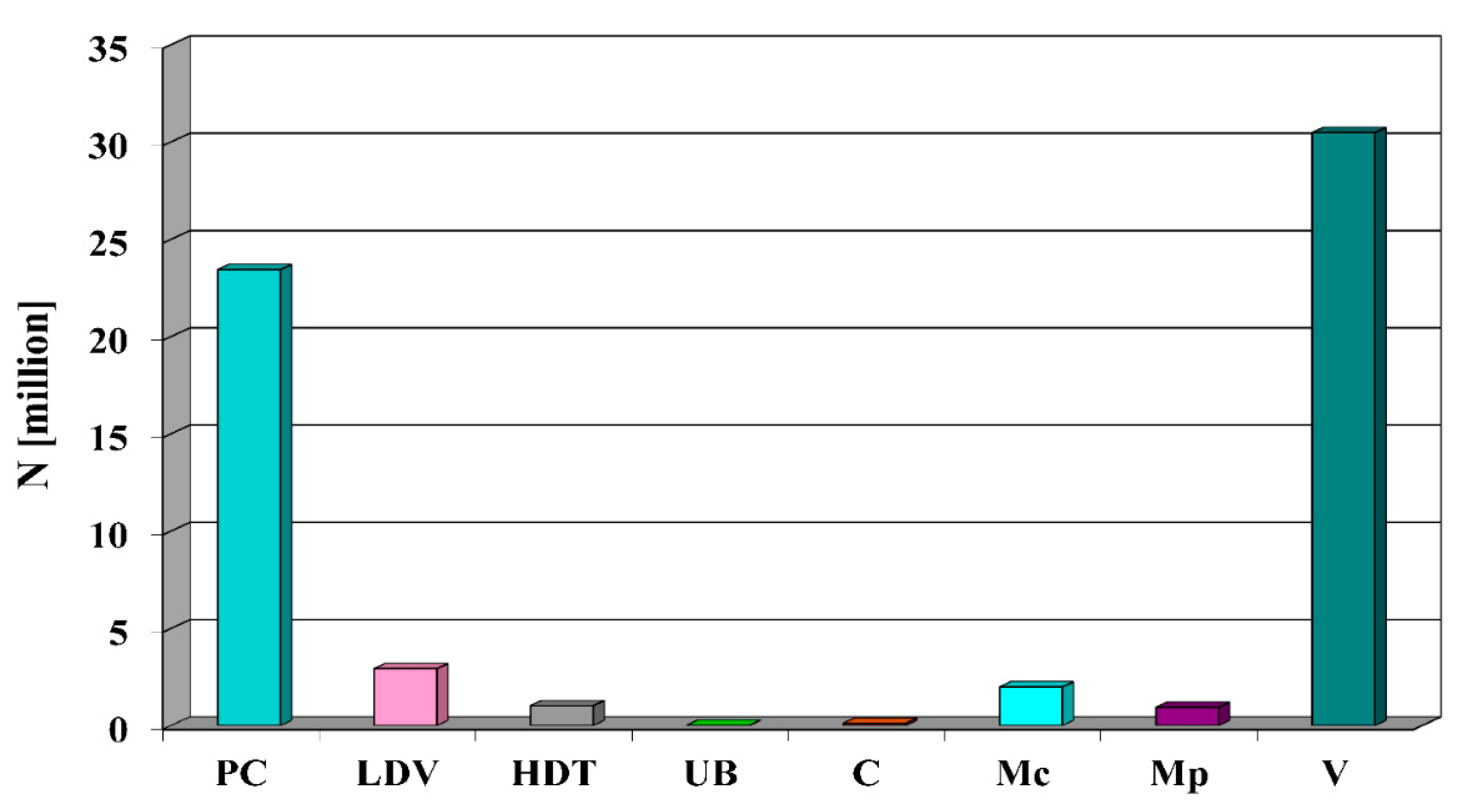
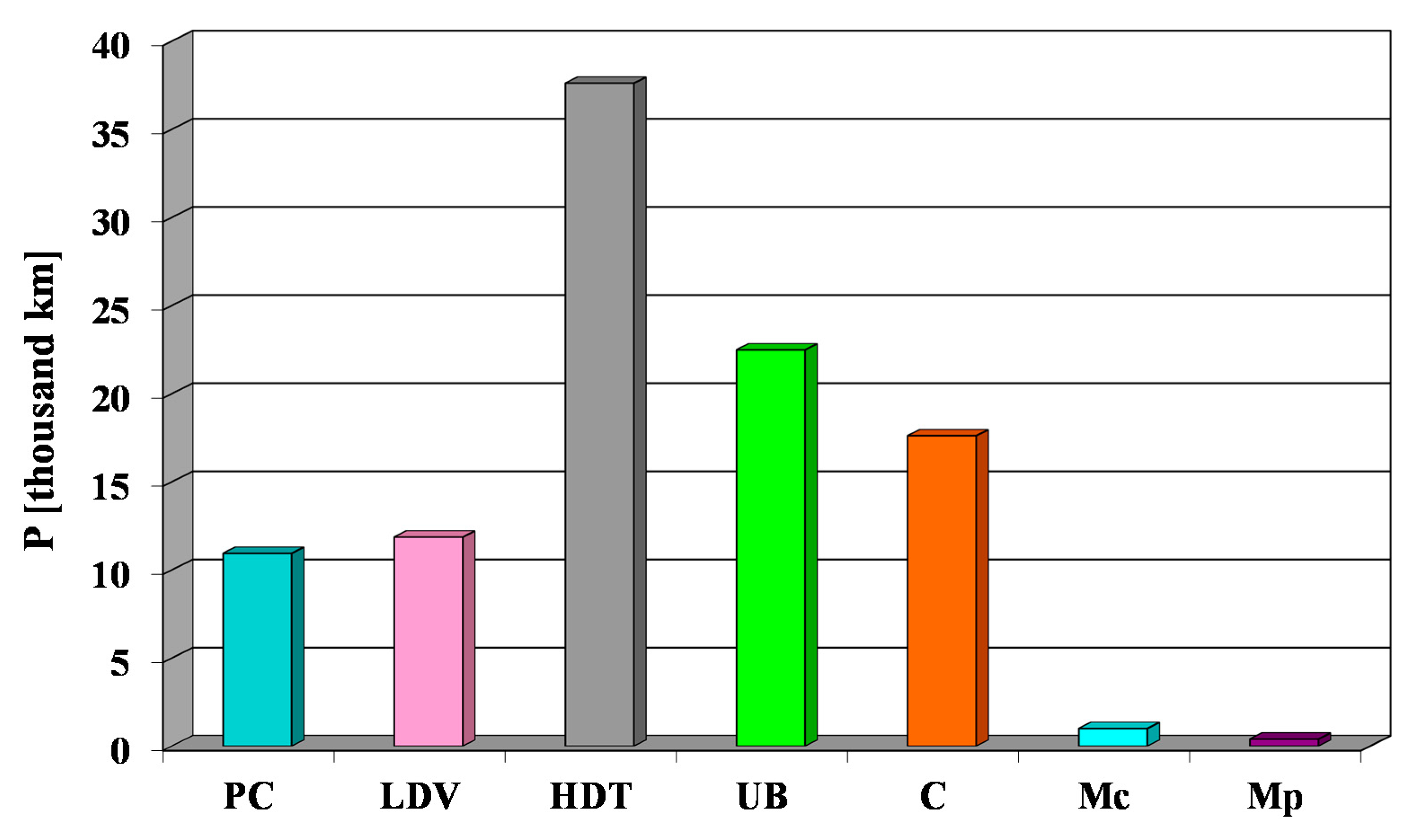
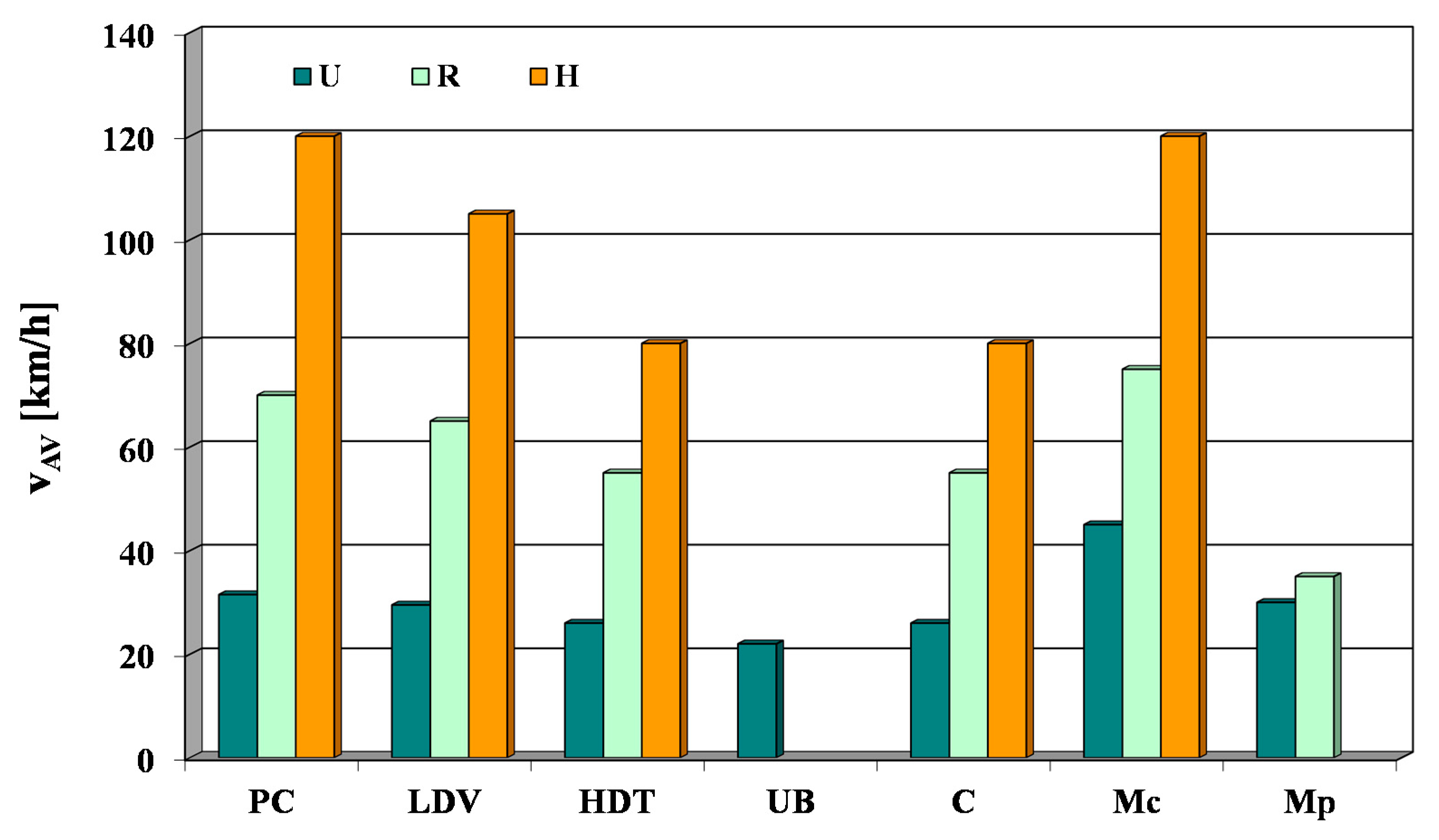
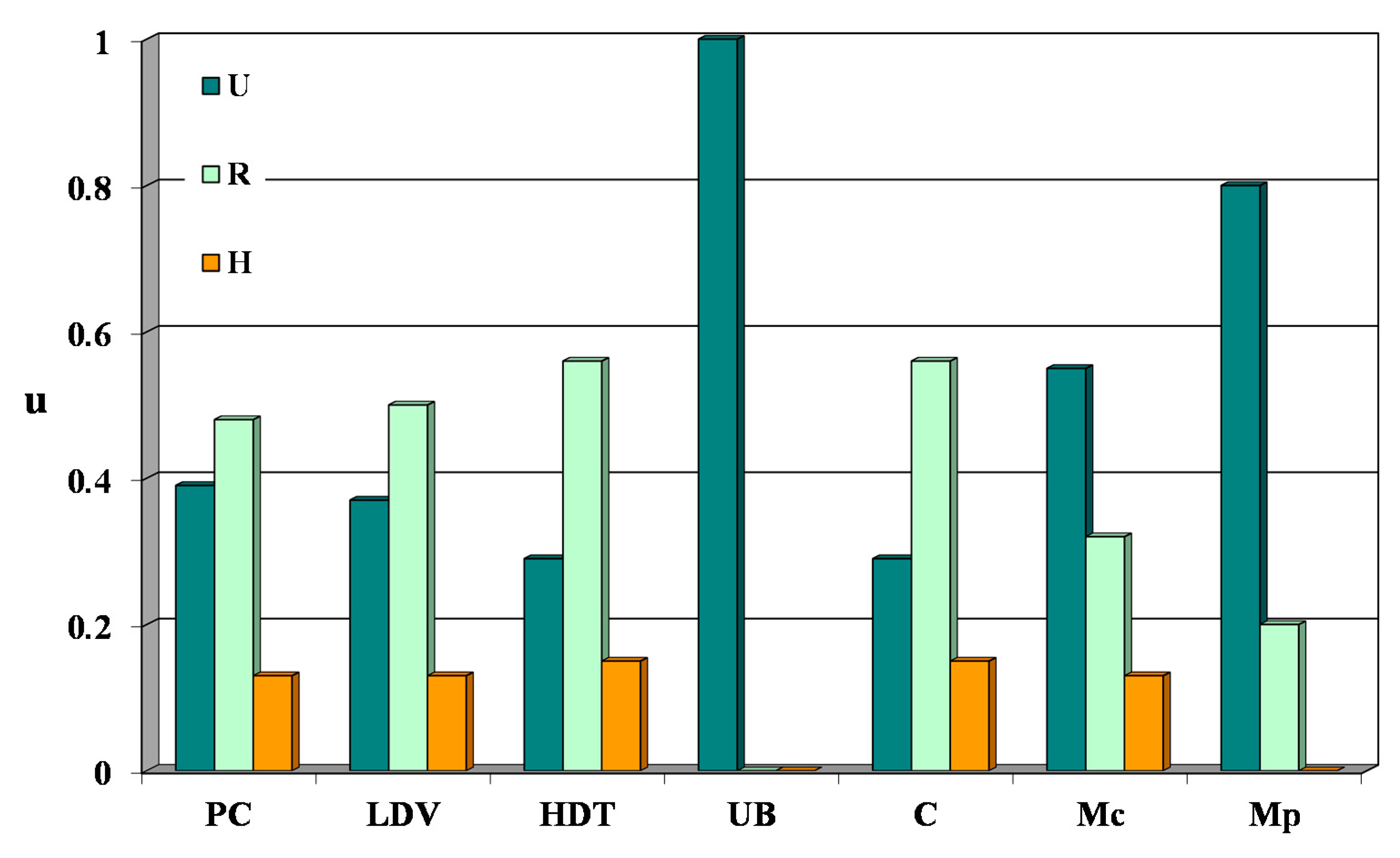
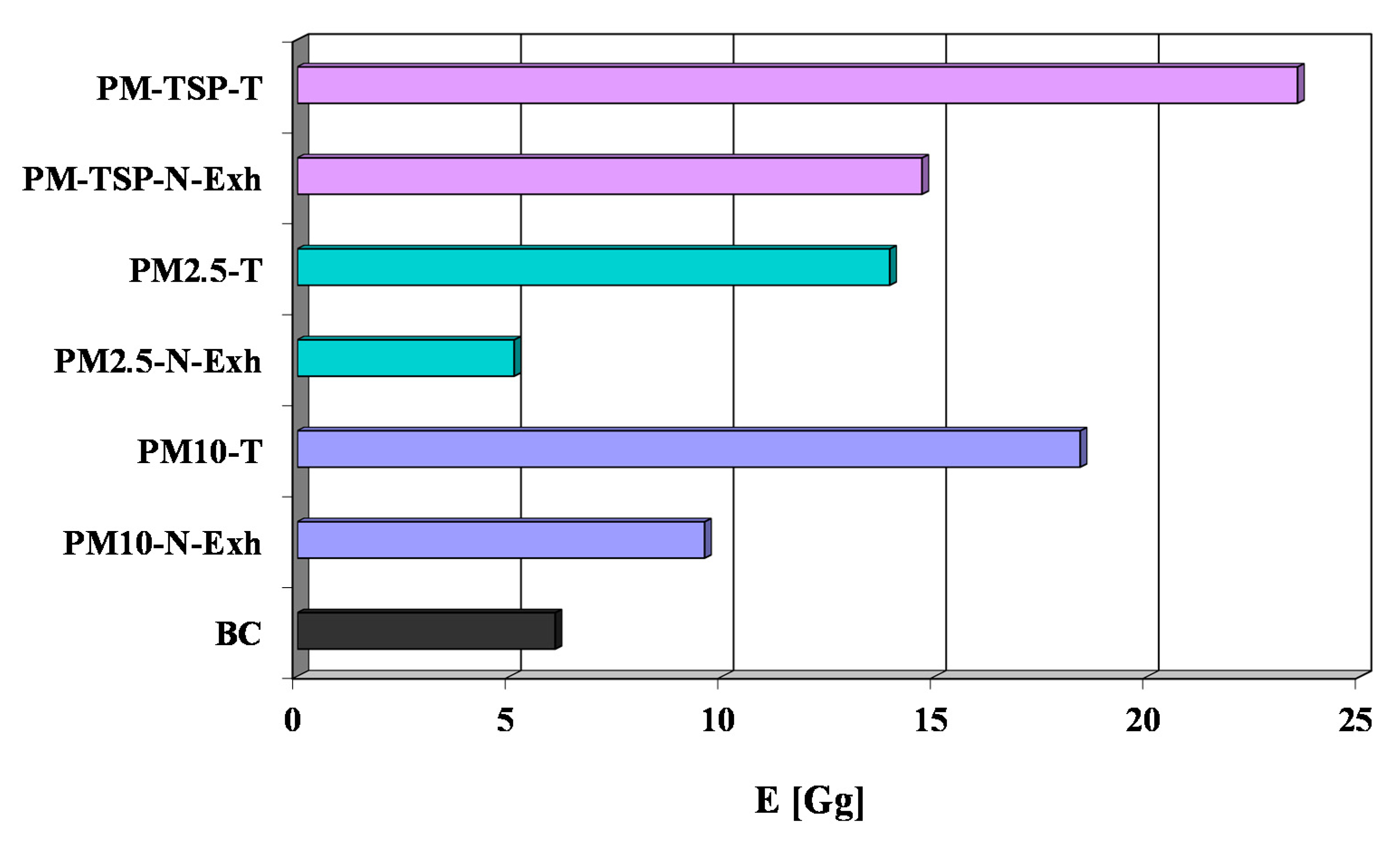
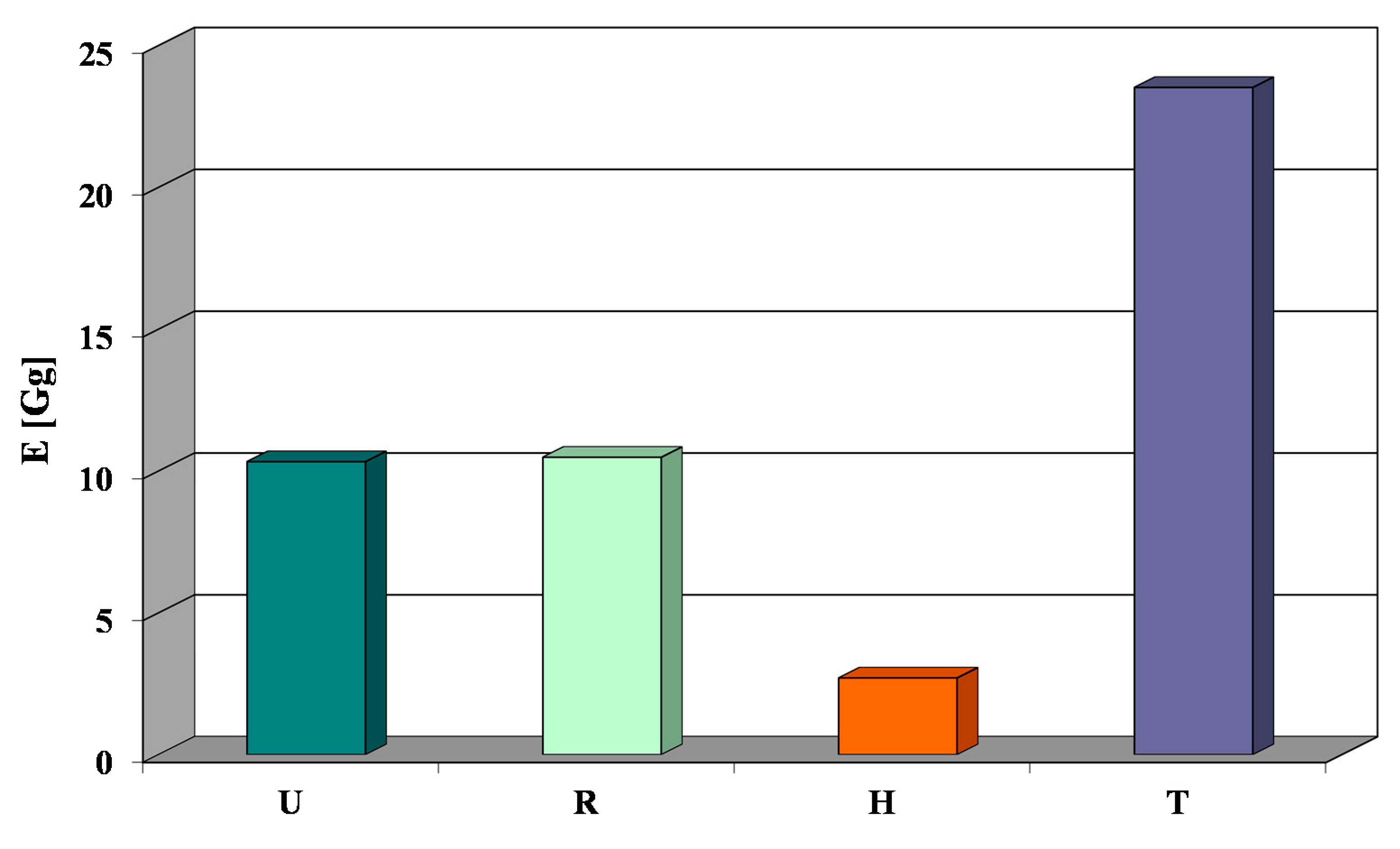
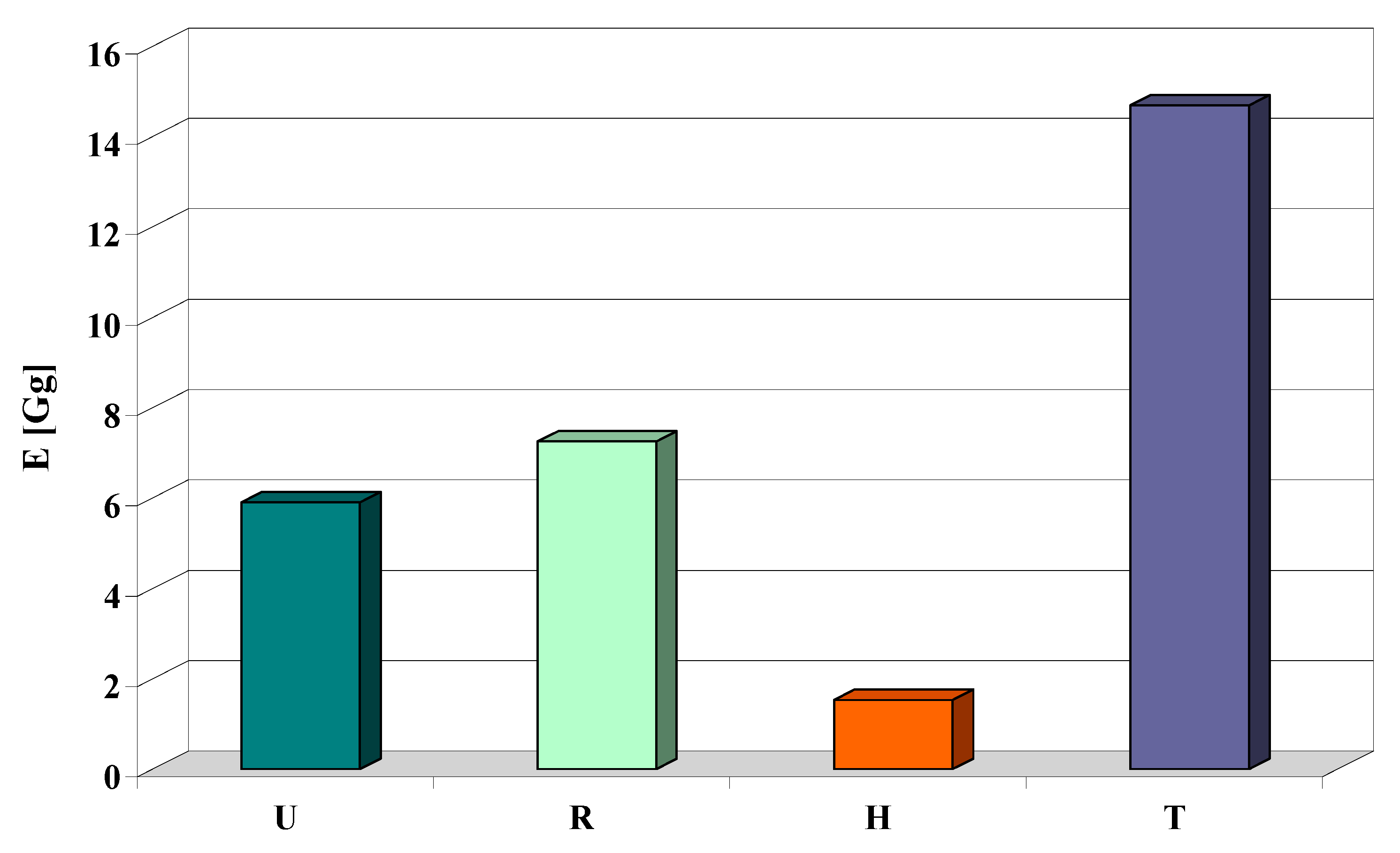
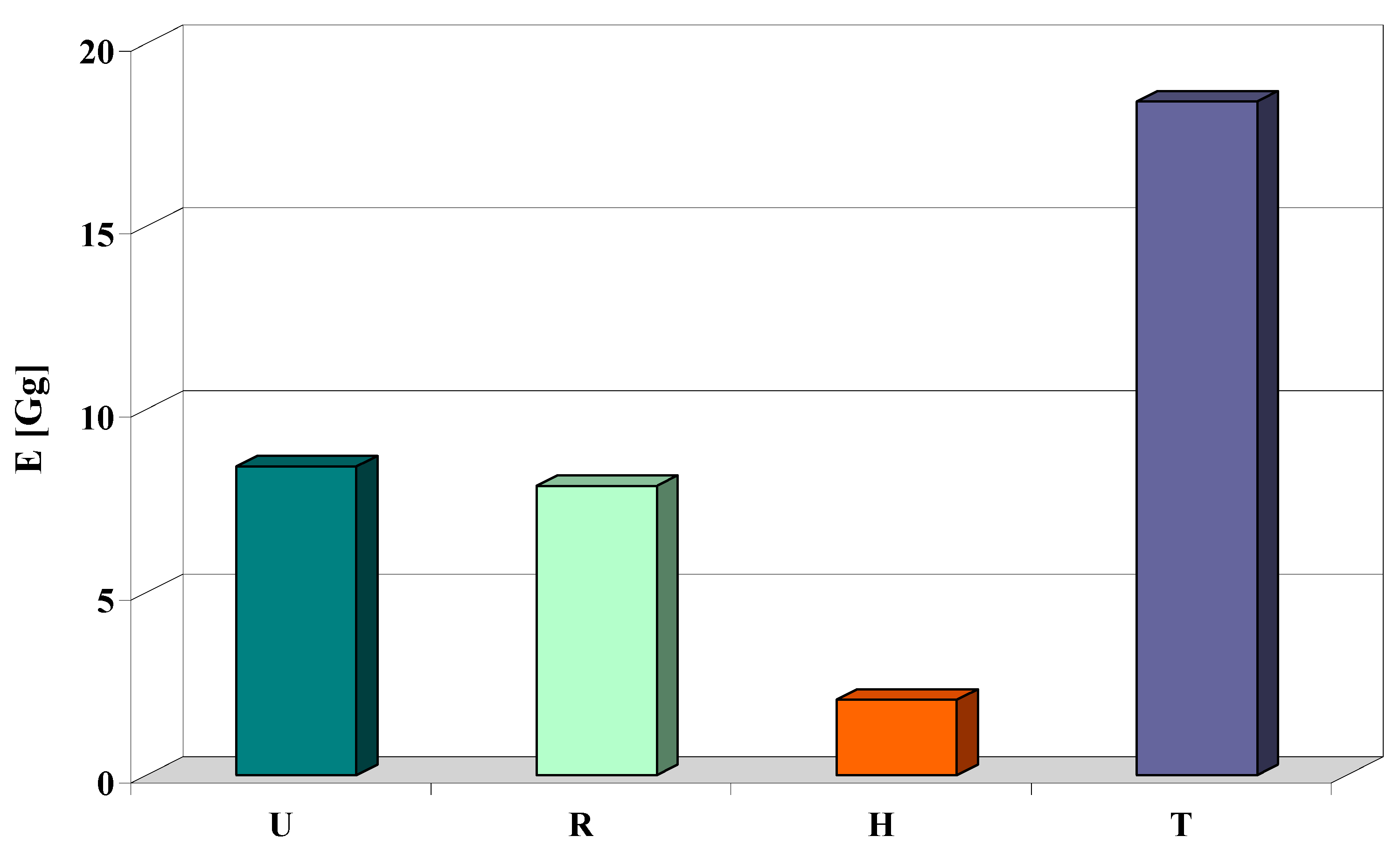
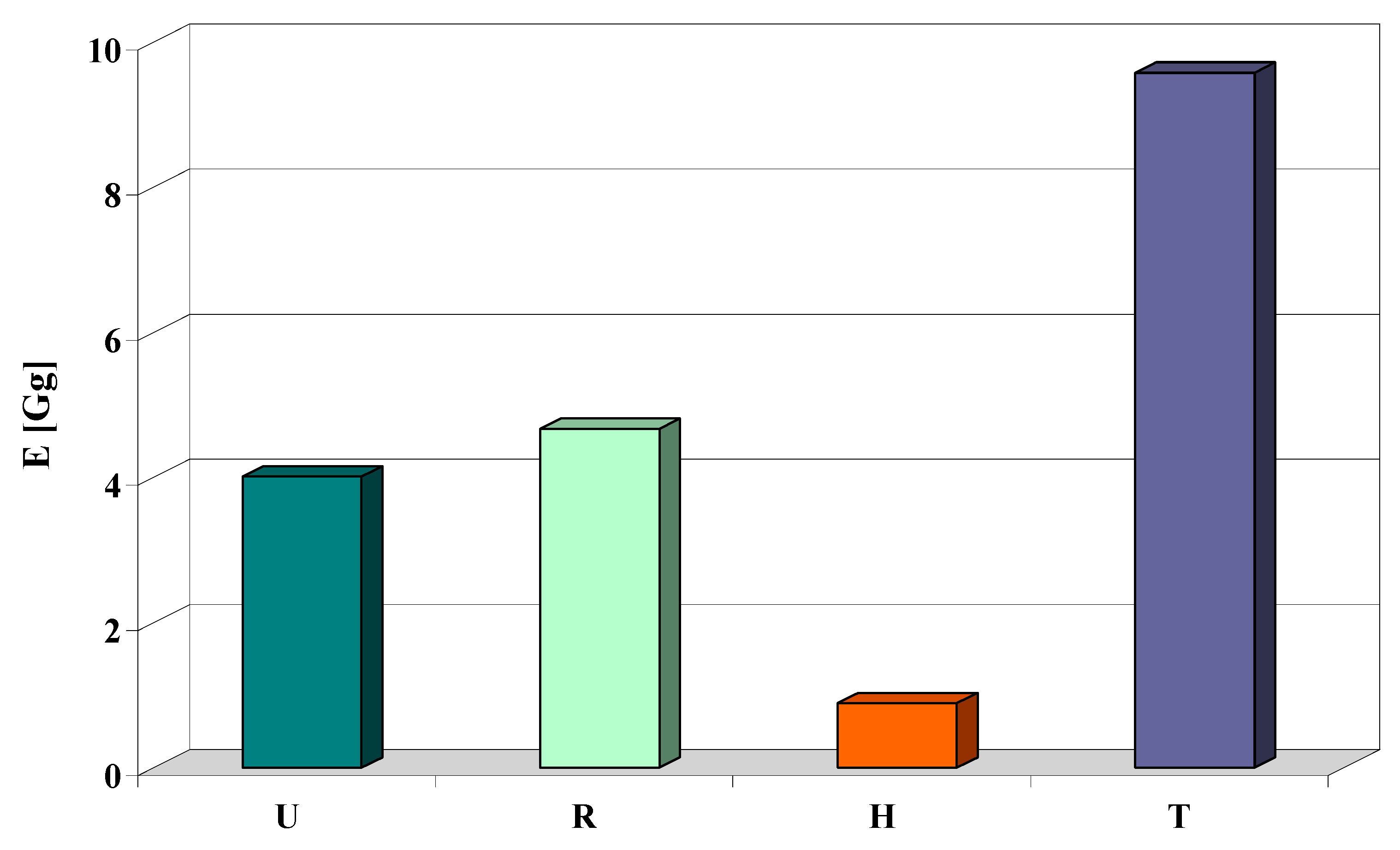
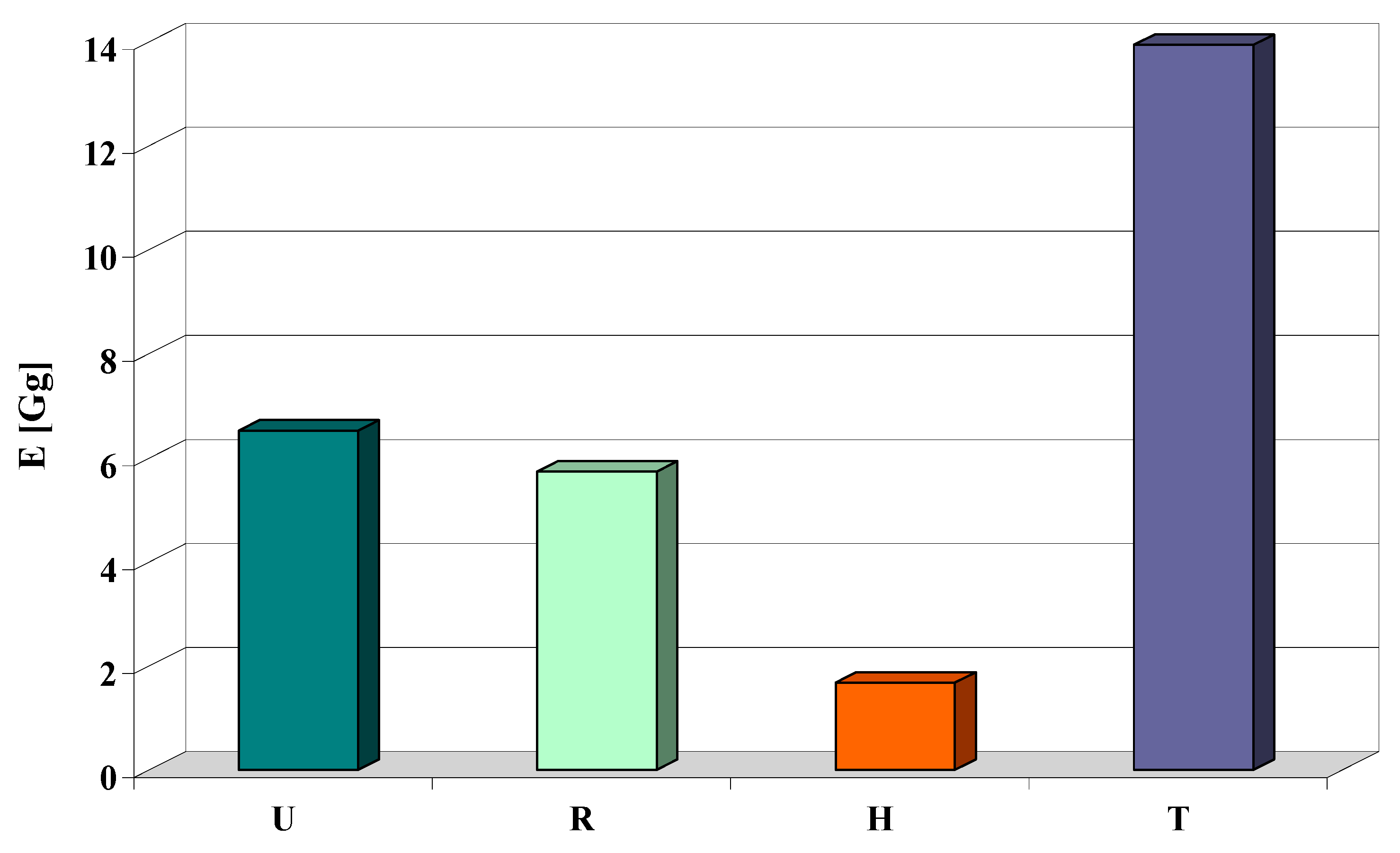
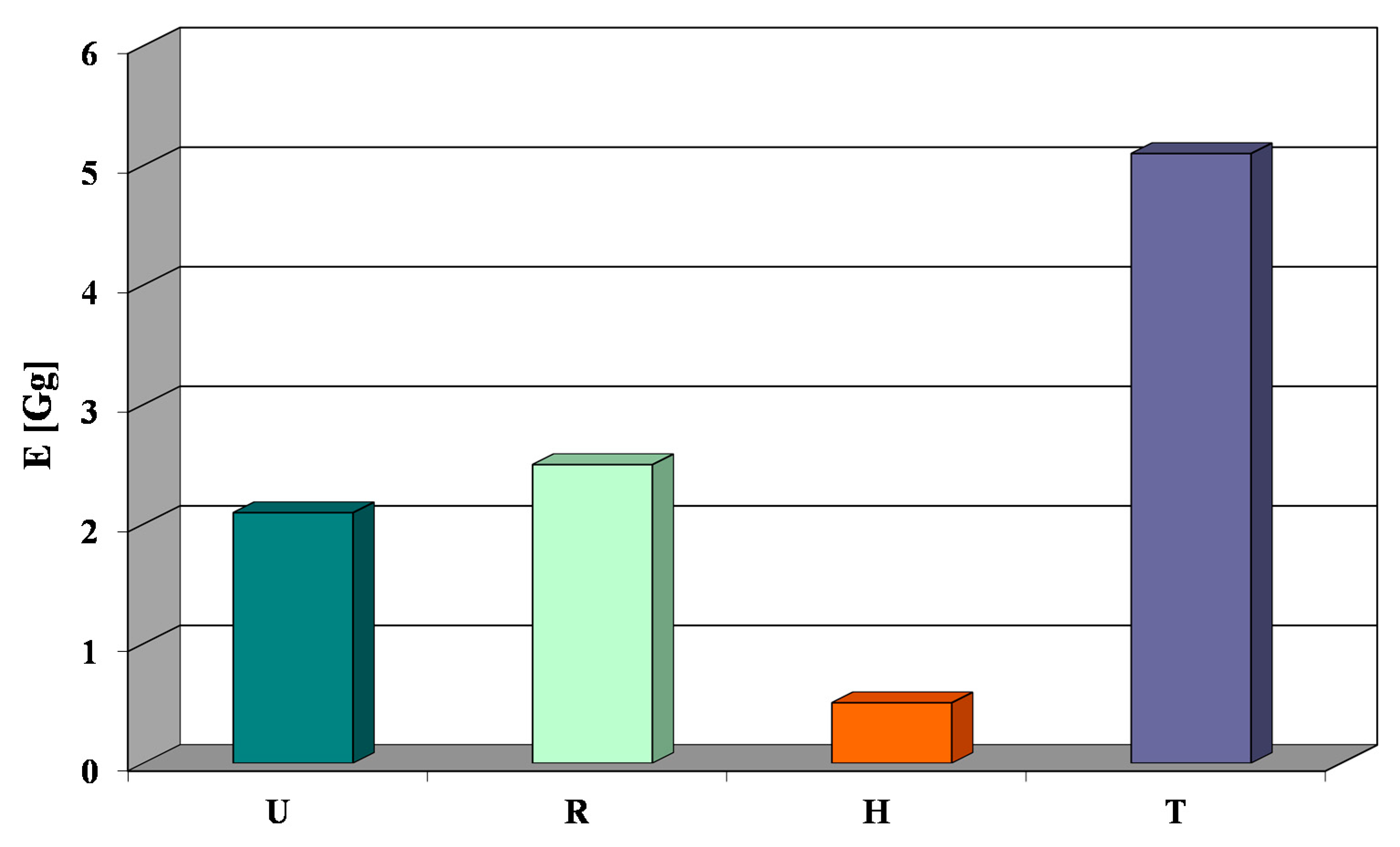
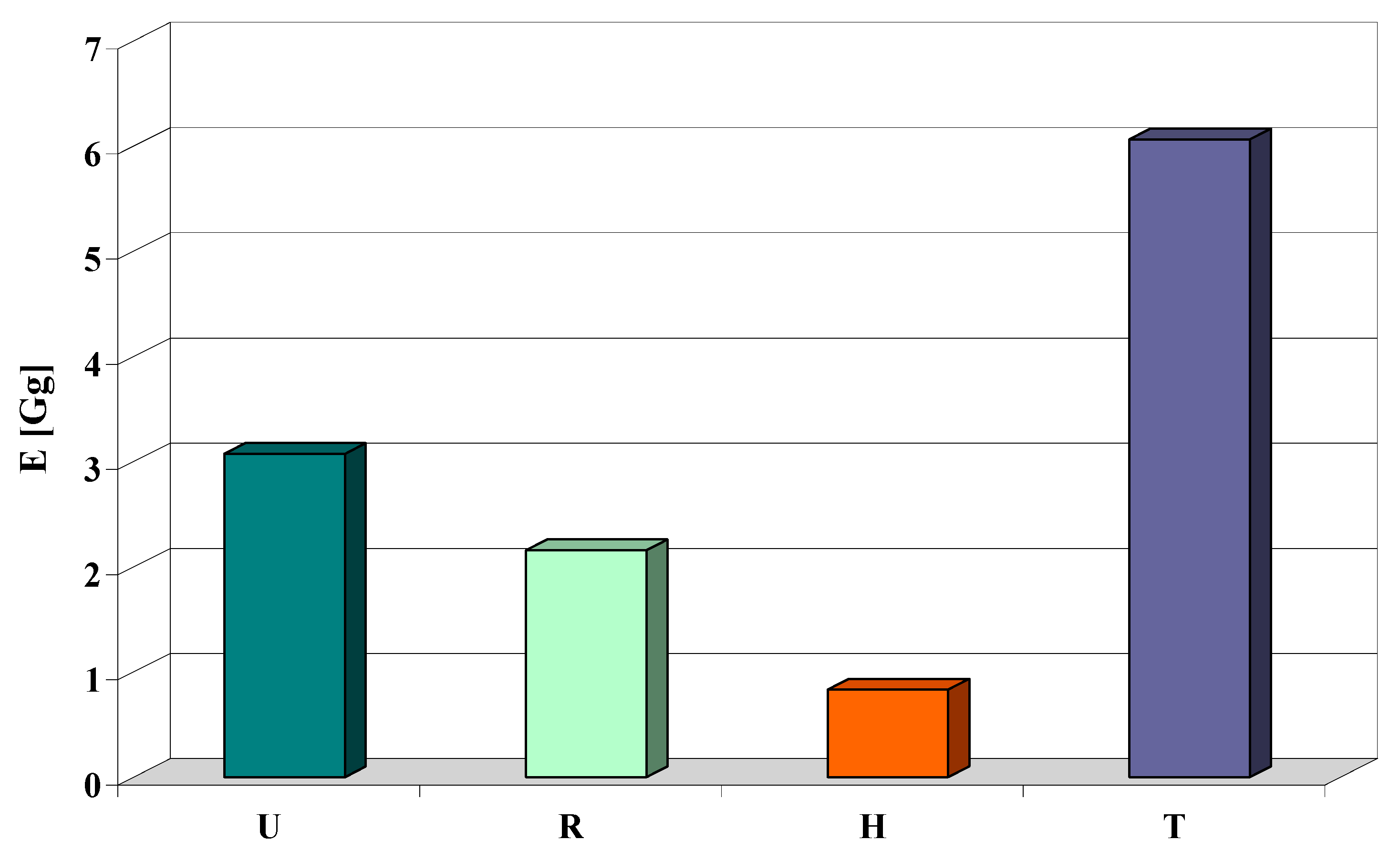
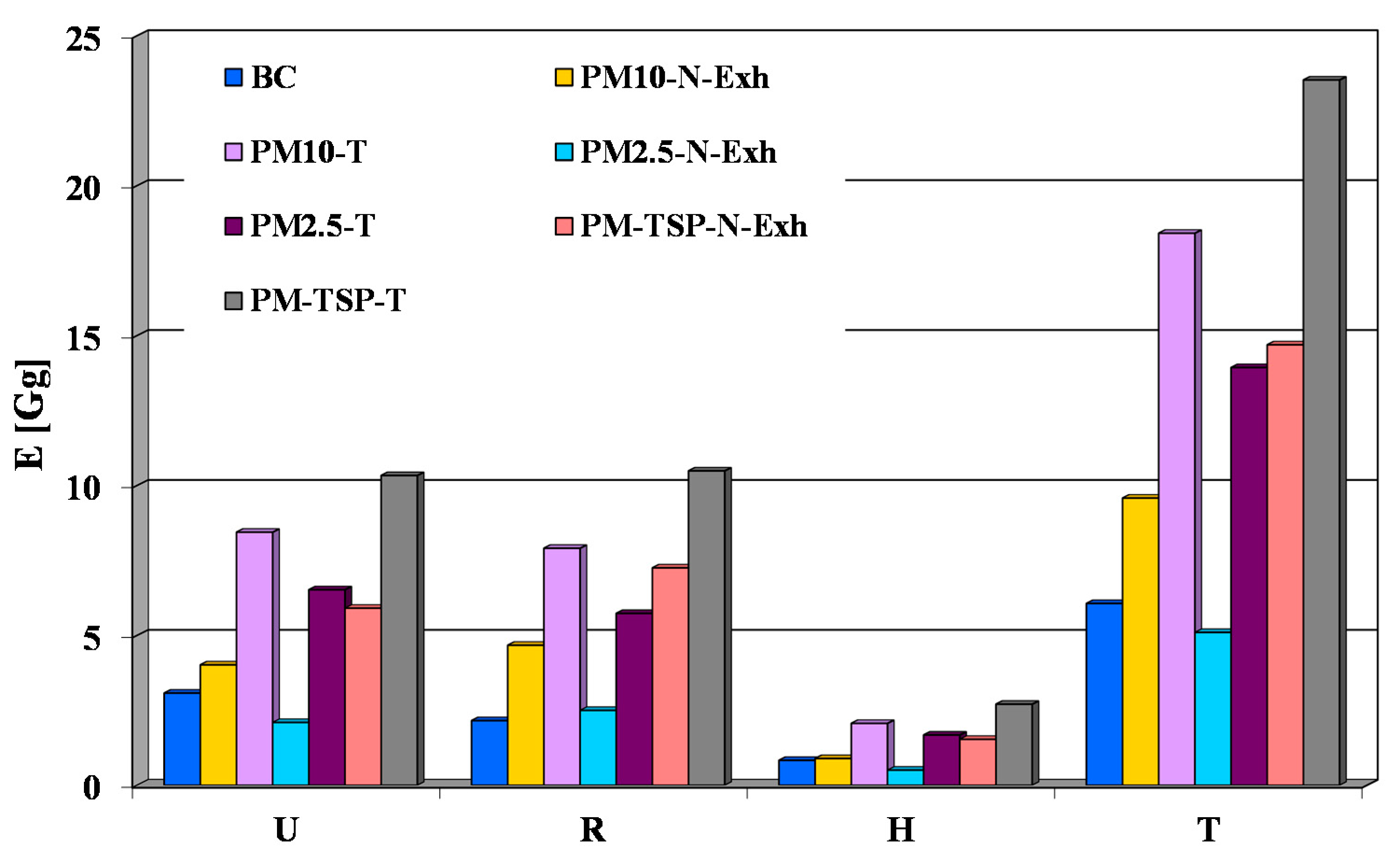
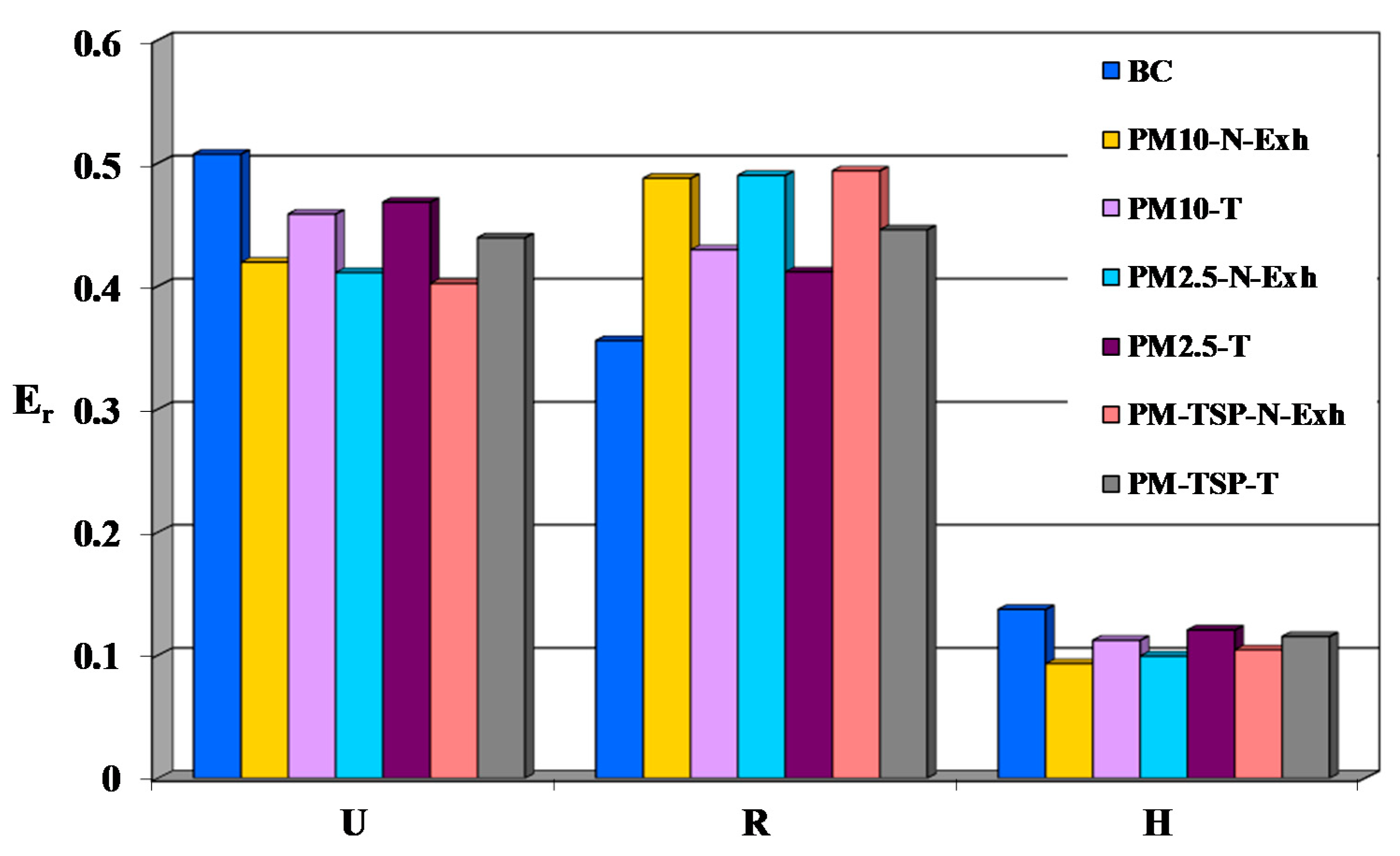
| Identification Data of the Legal Act | Issue Covered by the Legal Act |
|---|---|
| Council Directive 96/62/EC of 27 September 1996 | Ambient air quality assessment and management. |
| Council Directive 1999/30/EC of 22 April 1999 | Limit values for sulphur dioxide, nitrogen dioxide and oxides of nitrogen, particulate matter and lead in ambient air. |
| Directive 2000/69/EC of the European Parliament and of the Council of 16 November 2000 | Limit values for benzene and carbon monoxide in ambient air. |
| Directive 2002/3/EC of the European Parliament and of the Council of 12 February 2002 | Ozone in ambient air. |
| Council Decision of 27 January 1997 | Establish a reciprocal exchange of information and data from networks and individual stations measuring ambient air pollution within Member States. |
| Identification Data of the Legal Act | Issue Covered by the Legal Act |
|---|---|
| Commission Regulation (EC) No 692/2008 of 18 July 2008 | Implementing and amending Regulation (EC) No 715/2007 of the European Parliament and of the Council on type-approval of motor vehicles with respect to emissions from light passenger and commercial vehicles (Euro 5 and Euro 6) and on access to vehicle repair and maintenance information. |
| Commission Regulation (EU) No 566/2011 of 8 June 2011 | Amending Regulation (EC) No 715/2007 of the European Parliament and of the Council and Commission Regulation (EC) No 692/2008 as regards access to vehicle repair and maintenance information. |
| Regulation (EC) No 595/2009 of the European Parliament and of the Council of 18 June 2009 | Type-approval of motor vehicles and engines with respect to emissions from heavy duty vehicles (Euro VI) and on access to vehicle repair and maintenance information and amending Regulation (EC) No 715/2007 and Directive 2007/46/EC and repealing Directives 80/1269/EEC, 2005/55/EC and 2005/78/EC. |
| Commission Regulation (EU) No 582/2011 of 25 May 2011 | Implementing and amending Regulation (EC) No 595/2009 of the European Parliament and of the Council with respect to emissions from heavy duty vehicles (Euro VI) and amending Annexes I and III to Directive 2007/46/EC of the European Parliament and of the Council. |
| Commission Regulation (EU) No 64/2012 of 23 January 2012 | Amending Regulation (EU) No 582/2011 implementing and amending Regulation (EC) No 595/2009 of the European Parliament and of the Council with respect to emissions from heavy duty vehicles (Euro VI) |
| Commission Regulation (EC) 715/2007 of the European Parliament and of the Council of 20 June 2007 | Type approval of motor vehicles with respect to emissions from light passenger and commercial vehicles (Euro 5 and Euro 6) and on access to vehicle repair and maintenance in-formation, European Commission (EC), Official J. European Union, L 171, 2007. |
| Commission Regulation (EU) 2016/427 of 10 March 2016 | Amending Regulation (EC) No. 692/2008 as regards emissions from light passenger and commercial vehicles (Euro 6), Verifying Real Driving Emissions, Official J. European Union, L 82, 2016. |
| Commission Regulation (EU) 2016/646 of 20 April 2016 | Amending Regulation (EC) No. 692/2008 as regards emissions from light passenger and commercial vehicles (Euro 6), Verifying Real Driving Emissions, Official J. European Union, L 109, 2016. |
| European Commission (2017) Regulation (EC) 2017/1151 of 1 June 2017 | Supplementing Regulation (EC) No 715/2007 of the European Parliament and of the Council on type-approval of motor vehicles with respect to emissions from light passenger and commercial vehicles (Euro 5 and Euro 6) and on access to vehicle repair and maintenance information, amending Directive 2007/46/EC of the European Parliament and of the Council, Commission Regulation (EC) No 692/2008 and Commission Regulation (EU) No 1230/2012 and repealing Commission Regulation (EC) No 692/2008. Official Journal of the European Union. L 175. |
| Sources of Particulate Matters or Their Emission Sources Classification | Classification of Particulate Matters or Their Emission Sources |
|---|---|
| Classification of particulate matters for the needs of the inventory [7,8,29] | total suspended particles (TSP); fine particles PM10 (PM10 particulate matter); fine particles PM2.5 (PM2.5 particulate matter); soot (black carbon) |
| Particulate matter emissions, TSP, PM10 and PM2.5 distinguished by [7,8,29] | total emissions; emissions from sources other than engine exhaust |
| Sources of particulate matter emissions other than engine exhaust including PM emission from vehicle tribological systems interacting with the environment, mainly [5,6,7,8,21,24,29] | from vehicle braking systems; from vehicle tires and roadway surfaces |
Publisher’s Note: MDPI stays neutral with regard to jurisdictional claims in published maps and institutional affiliations. |
© 2021 by the authors. Licensee MDPI, Basel, Switzerland. This article is an open access article distributed under the terms and conditions of the Creative Commons Attribution (CC BY) license (https://creativecommons.org/licenses/by/4.0/).
Share and Cite
Bebkiewicz, K.; Chłopek, Z.; Sar, H.; Szczepański, K.; Zimakowska-Laskowska, M. Assessment of Environmental Risks of Particulate Matter Emissions from Road Transport Based on the Emission Inventory. Appl. Sci. 2021, 11, 6123. https://doi.org/10.3390/app11136123
Bebkiewicz K, Chłopek Z, Sar H, Szczepański K, Zimakowska-Laskowska M. Assessment of Environmental Risks of Particulate Matter Emissions from Road Transport Based on the Emission Inventory. Applied Sciences. 2021; 11(13):6123. https://doi.org/10.3390/app11136123
Chicago/Turabian StyleBebkiewicz, Katarzyna, Zdzisław Chłopek, Hubert Sar, Krystian Szczepański, and Magdalena Zimakowska-Laskowska. 2021. "Assessment of Environmental Risks of Particulate Matter Emissions from Road Transport Based on the Emission Inventory" Applied Sciences 11, no. 13: 6123. https://doi.org/10.3390/app11136123
APA StyleBebkiewicz, K., Chłopek, Z., Sar, H., Szczepański, K., & Zimakowska-Laskowska, M. (2021). Assessment of Environmental Risks of Particulate Matter Emissions from Road Transport Based on the Emission Inventory. Applied Sciences, 11(13), 6123. https://doi.org/10.3390/app11136123






